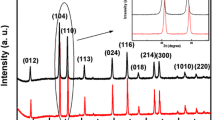Abstract
Nanoparticles (NPs) of pure and Eu-doped hematite were prepared by a wet chemical technique; their structure, size and morphology were determined by XRD and transmission electron microscopy. The magnetic properties were measured in the 6–320 K temperature range by vibrating-sample magnetometry. Pure hematite NPs exhibit a pseudo-cubic shape with a size of about 74 nm; addition of trivalent Eu cations in different amounts (Eu/Fe atomic ratios 2.4 %) brings about a definite change in particle morphology with the development of rice-grain like NPs with aspect ratios of about 2.8. Trivalent Eu cations act as magnetic defects making the overall antiferromagnetic arrangement of hematite host less robust. A large defect magnetism arises below the Morin transition temperature. The resulting uncompensated moments on NPs (mostly arising from the NP cores) behave superparamagnetically before undergoing single-particle blocking at about 40 K. Instead, uncompensated moments in pure hematite NPs mostly occur at the NP surface and lead to standard defect ferromagnetism. Above the Morin temperature, the usual spin-canted ferromagnetism is observed in all samples, although it is somewhat inhibited by Eu addition.









Similar content being viewed by others
References
Amin N, Arajs S (1987) Morin temperature of annealed submicronic α-Fe2O3 particles. Phys Rev Lett 35:4810–4811
Ananth KP, Gielisse PJ, Rockett TJ (1974) Synthesis and characterization of Europium sulfide. Mat Res Bull (Pergamon Press) 9:1167–1172
Artman JO, Murphy JC, Foner S (1965) Magnetic anisotropy in antiferromagnetic corundum-type sesquioxides. Phys Rev 138:A912–A917
Ashtaputre SS, Deshpande A, Marathe S, Wankhede ME, Chimanpure J, Pasricha R, Urban J, Kharam SK, Gosavi SV, Kulkarni SK (2007) Synthesis and analysis of ZnO and CdSe nanoparticles. Pramana—J Phys 65:615–620 ISSN: 0304-4289
Besser PJ, Morrish AH, Searle CW (1967) Magnetocrystalline anisotropy of pure and doped hematite. Phys Rev 153:632–642
Bødker F, Hansen MF, Bender Koch C, Lefmann K, Mørup S (2000) Magnetic properties of hematite nanoparticles. Phys Rev 61:6826–6838
Bowles J, Jackson M, Banerjee SK (2010) Interpretation of low-temperature data Part II: the Hematite Morin transition. IRM Quart 20:1–10 ISSN: 2152-1972
Caro P (1998) Rare earths in luminescence. In: Saez R, Caro PI (eds) Rare earths. Editorial Complutense, Madrid. ISBN 978-84-89784-33-8
Chikazumi S (1997) Physics of ferromagnetism 1997 edition, 1997th edn. Oxford University Press, Oxford. ISBN 0-19-851776-9
Cornell RM, Schwertmann U (2003) The iron oxides: structure, properties, reactions, occurrences and uses, 2nd, Completely Revised and Extended Edition edn. Wiley, New York. ISBN 3-527-30274-3
Cullity BD, Graham CD (2008) Introduction to magnetic materials, 2nd edn. IEEE Press, Wiley, Hoboken. doi:10.1002/9780470386323
de Boer CB, Mulleder TAT, Dekkers MJ (2001) Low-temperature behaviour of haematite: susceptibility and magnetization increase on cycling through the Morin transition. Geophys J Int 146:201–216. doi:10.1046/j.0956-540x.2001.01443.x
Dunlop DJ, Özdemir Ö (1997) Rock magnetism: fundamentals and frontiers., Cambridge studies in magnetism seriesCambridge University Press, Cambridge. ISBN 978-0521325145
Freyria FS, Barrera G, Tiberto P, Belluso E, Levy D, Saracco G, Allia P, Garrone E, Bonelli B (2013) Eu-doped α-Fe2O3 nanoparticles with modified magnetic properties. J Sol St Chem 201:302–311. doi:10.1016/j.jssc.2013.03.018
Jamauchi J (2008) Fundamentals of magnetism. In: Likhtenshtein GI, Jamauchi J, Nakatsuji S, Smirnov AI, Tamura R (eds) Nitroxides: applications in chemistry, biomedicine, and materials science. Willey-Vch Verlag GmbH & Co. KGaA, Weinheim. ISBN 978-3-527-31889-6
Jensen J, Mackintosh AR (1991) Rare earth magnetism—structures and excitations. Clarendon Press, Oxford. ISBN 978-0198520276
Jiang Z, Liu Q, Barrón V, Torrent J, Yu Y (2012) Magnetic discrimination between Al-substituted hematites synthesized by hydrothermal and thermal dehydration methods and its geological significance. J Geophys Res 117:B02102-1–B02102-15. doi:10.1029/2011JB008605
Kodma RH, Berkowitz AE (2005) Surface-driven effects on the magnetic behavior of oxide nanoparticles. In: Fiorani D (ed) Surface effects in magnetic nanoparticles. Springer Science + Business Media, New York. ISBN 978-0387232799
Lin X-M, Samia ACS (2006) Synthesis, assembly and physical properties of magnetic nanoparticles. J Magn Magn Mater 305:100–109. doi:10.1016/j.jmmm.2005.11.042
Liu Q, Barrón V, Torrent J, Qin H, Yu Y (2010) The magnetism of micro-sized hematite explained. Phys Earth Plan Inter 183:387–397. doi:10.1016/j.pepi.2010.08.008
Lu A-H, Salabas L, Schüth F (2007) Magnetic nanoparticles: synthesis, protection, functionalization, and application. Angew Chem Int Ed 46:1222–1244. doi:10.1002/anie.200602866
Morrish AH (1995) Canted antiferromagnetism: hematite. World Scientific, River Edge. ISBN 978-981-02-2007-5
Özdemir Ö, Dunlop DJ (2006) Magnetic memory and coupling between spin-canted and defect magnetism in Hematite. J Geophys Res 111:B12S03-1–B12S03-13. doi:10.1029/2006JB004555
Özdemir Ö, Dunlop DJ, Berquó TS (2008) Morin transition in hematite: size dependence and thermal hysteresis. Geochem Geophys Geosyst 9:1–12. doi:10.1029/2008GC002110
Smith SJ, Page K, Kim H, Campbell BJ, Boerio-Goates J, Woodfield BF (2012) Novel synthesis and structural analysis of ferrihydrite. Inorg Chem 51:6421–6424. doi:10.1021/ic300937f
Song H, Wang J, Chen B, Peng H, Lu S (2003) Size-dependent electronic transition rates in cubic nanocrystalline europium doped yttria. Chem Phys Lett 376:1–5. doi:10.1016/S0009-2614(03)00810-8
Zhao J, Huggins FE, Feng Z, Huffman GP (1994) Ferrihydrite; surface structure and its effects on phase transformation. Clays Clay Miner 42:737–746
Author information
Authors and Affiliations
Corresponding author
Rights and permissions
About this article
Cite this article
Allia, P., Barrera, G., Bonelli, B. et al. Magnetic properties of pure and Eu-doped hematite nanoparticles. J Nanopart Res 15, 2118 (2013). https://doi.org/10.1007/s11051-013-2118-z
Received:
Accepted:
Published:
DOI: https://doi.org/10.1007/s11051-013-2118-z




